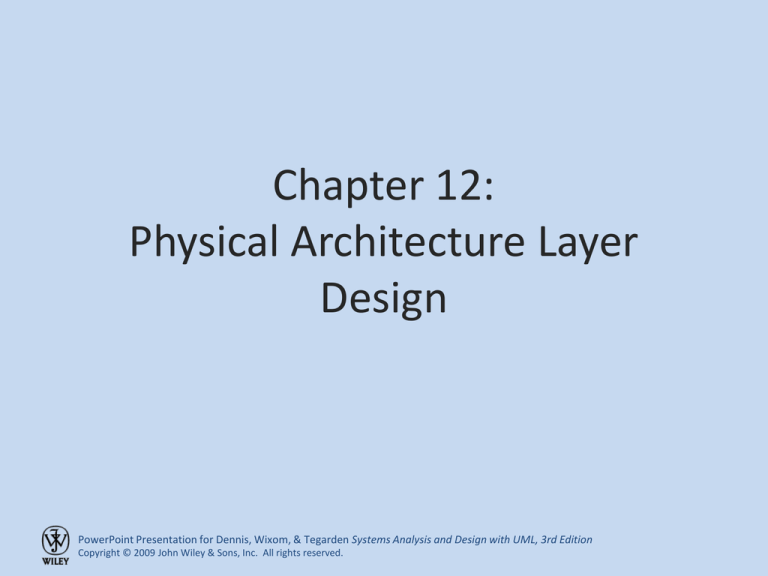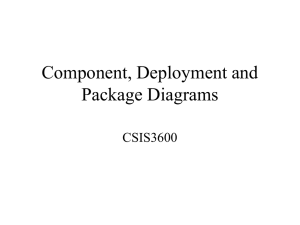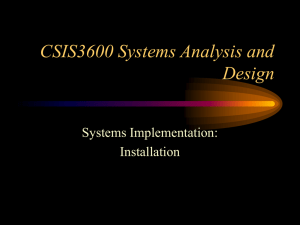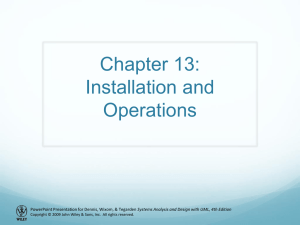
Chapter 12:
Physical Architecture Layer
Design
PowerPoint Presentation for Dennis, Wixom, & Tegarden Systems Analysis and Design with UML, 3rd Edition
Copyright © 2009 John Wiley & Sons, Inc. All rights reserved.
Objectives
• Understand the different physical architecture components.
• Understand server-based, client-based, and client–server
physical architectures.
• Be familiar with distributed objects computing.
• Be able to create a network model using a deployment
diagram.
• Understand how operational, performance, security, cultural,
and political requirements affect the design of the physical
architecture layer.
• Be familiar with how to create a hardware and software
specification.
PowerPoint Presentation for Dennis, Wixom, & Tegarden Systems Analysis and Design with UML, 3rd Edition
Copyright © 2009 John Wiley & Sons, Inc. All rights reserved.
Introduction
• Most modern systems span two or more
networked computers
• The physical architecture layer design specifies
– How the system will be distributed across the
computers
– What hardware and software will be used
• Most systems’ design is constrained by
existing systems and networks
PowerPoint Presentation for Dennis, Wixom, & Tegarden Systems Analysis and Design with UML, 3rd Edition
Copyright © 2009 John Wiley & Sons, Inc. All rights reserved.
ELEMENTS OF THE PHYSICAL
ARCHITECTURE LAYER
PowerPoint Presentation for Dennis, Wixom, & Tegarden Systems Analysis and Design with UML, 3rd Edition
Copyright © 2009 John Wiley & Sons, Inc. All rights reserved.
Architectural Components
• Software components
– Data storage
– Data access logic
– Application logic
– Presentation logic
• Hardware components
– Computers (clients, servers)
– Networks
PowerPoint Presentation for Dennis, Wixom, & Tegarden Systems Analysis and Design with UML, 3rd Edition
Copyright © 2009 John Wiley & Sons, Inc. All rights reserved.
Server-Based Architectures
• The server performs all four application
functions
• The client only needed a monitor, a keyboard,
and a communications device (e.g. modem)
Data Storage
Data Access Logic
Application Logic
Presentation Logic
PowerPoint Presentation for Dennis, Wixom, & Tegarden Systems Analysis and Design with UML, 3rd Edition
Copyright © 2009 John Wiley & Sons, Inc. All rights reserved.
Client-Based Architectures
• All logic resides on the client computer
• A separate computer may hold the data
• Simple to develop, but difficult to maintain
Data Access Logic
Application Logic
Presentation Logic
Data Storage
PowerPoint Presentation for Dennis, Wixom, & Tegarden Systems Analysis and Design with UML, 3rd Edition
Copyright © 2009 John Wiley & Sons, Inc. All rights reserved.
Client-Server Architectures
• Balance processing between client and server
• Predominant architecture in modern systems
• Amount of client processing varies
– Thin clients do only presentation logic
– Thick clients do presentation and application
Application Logic
Presentation Logic
Data Storage
Data Access Logic
PowerPoint Presentation for Dennis, Wixom, & Tegarden Systems Analysis and Design with UML, 3rd Edition
Copyright © 2009 John Wiley & Sons, Inc. All rights reserved.
Client-Server Tiers
• Client server architectures can have two or
more tiers depending on application logic
partitioning
– 2-tier: all application and data logic on one server
– 3-tier: application logic on one server, data logic
on another
– 4-tier: application logic split among two servers,
data logic on another
• Sometimes called an n-tier architecture
PowerPoint Presentation for Dennis, Wixom, & Tegarden Systems Analysis and Design with UML, 3rd Edition
Copyright © 2009 John Wiley & Sons, Inc. All rights reserved.
Distributed Objects Computing
• Next generation of client-server computing
• The client need not know which server to call
• Middleware intercepts the client request and
sends it to the appropriate server
• Three competing approaches
– CORBA
– Enterprise Java Beans
– .NET
PowerPoint Presentation for Dennis, Wixom, & Tegarden Systems Analysis and Design with UML, 3rd Edition
Copyright © 2009 John Wiley & Sons, Inc. All rights reserved.
Selecting a Physical Architecture
•
•
•
•
•
•
Cost of infrastructure
Cost of development
Ease of development
Interface capabilities
Control and security
Scalability
PowerPoint Presentation for Dennis, Wixom, & Tegarden Systems Analysis and Design with UML, 3rd Edition
Copyright © 2009 John Wiley & Sons, Inc. All rights reserved.
Architecture Characteristics
Server-Based
Client-Based
Client-Server
Cost of
infrastructure
Very high
Medium
Low
Cost of
development
Medium
Low
High
Ease of
development
Low
High
Low-Medium
Interface
capabilities
Low
High
High
Control and
Security
High
Low
Medium
Scalability
Low
Medium
High
PowerPoint Presentation for Dennis, Wixom, & Tegarden Systems Analysis and Design with UML, 3rd Edition
Copyright © 2009 John Wiley & Sons, Inc. All rights reserved.
INFRASTRUCTURE DESIGN
PowerPoint Presentation for Dennis, Wixom, & Tegarden Systems Analysis and Design with UML, 3rd Edition
Copyright © 2009 John Wiley & Sons, Inc. All rights reserved.
Deployment Diagram
• Represent relationships between hardware
components of an information system
• Elements of a deployment diagram
– Nodes: a computational resource
– Artifacts: a piece of the information system which
will be installed on a node
– Communication paths: a communication link such
as a network connection or a USB cable
PowerPoint Presentation for Dennis, Wixom, & Tegarden Systems Analysis and Design with UML, 3rd Edition
Copyright © 2009 John Wiley & Sons, Inc. All rights reserved.
Sample Deployment Diagram
PowerPoint Presentation for Dennis, Wixom, & Tegarden Systems Analysis and Design with UML, 3rd Edition
Copyright © 2009 John Wiley & Sons, Inc. All rights reserved.
Network Model
• Shows the major components of the
information system and their geographic
locations throughout the organization
• Purposes of the network model:
– To convey the complexity of the system
– To show how the system’s software components
will fit together
PowerPoint Presentation for Dennis, Wixom, & Tegarden Systems Analysis and Design with UML, 3rd Edition
Copyright © 2009 John Wiley & Sons, Inc. All rights reserved.
Sample Network Model
PowerPoint Presentation for Dennis, Wixom, & Tegarden Systems Analysis and Design with UML, 3rd Edition
Copyright © 2009 John Wiley & Sons, Inc. All rights reserved.
NONFUNCTIONAL REQUIREMENTS
PowerPoint Presentation for Dennis, Wixom, & Tegarden Systems Analysis and Design with UML, 3rd Edition
Copyright © 2009 John Wiley & Sons, Inc. All rights reserved.
Nonfunctional Requirement Types
•
•
•
•
Operational
Performance
Security
Cultural and Political
PowerPoint Presentation for Dennis, Wixom, & Tegarden Systems Analysis and Design with UML, 3rd Edition
Copyright © 2009 John Wiley & Sons, Inc. All rights reserved.
Operational Requirements
PowerPoint Presentation for Dennis, Wixom, & Tegarden Systems Analysis and Design with UML, 3rd Edition
Copyright © 2009 John Wiley & Sons, Inc. All rights reserved.
Performance Requirements
PowerPoint Presentation for Dennis, Wixom, & Tegarden Systems Analysis and Design with UML, 3rd Edition
Copyright © 2009 John Wiley & Sons, Inc. All rights reserved.
Security Requirements
PowerPoint Presentation for Dennis, Wixom, & Tegarden Systems Analysis and Design with UML, 3rd Edition
Copyright © 2009 John Wiley & Sons, Inc. All rights reserved.
Cultural & Political Requirements
PowerPoint Presentation for Dennis, Wixom, & Tegarden Systems Analysis and Design with UML, 3rd Edition
Copyright © 2009 John Wiley & Sons, Inc. All rights reserved.
Summary
• Elements of the Physical Architecture Layer
• Infrastructure Design
• Nonfunctional Requirements
PowerPoint Presentation for Dennis, Wixom, & Tegarden Systems Analysis and Design with UML, 3rd Edition
Copyright © 2009 John Wiley & Sons, Inc. All rights reserved.










